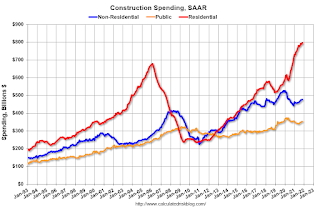https://ift.tt/3Hw4ibD
From the Census Bureau reported that overall construction spending increased 0.2%:
Construction spending during November 2021 was estimated at a seasonally adjusted annual rate of $1,625.9 billion, 0.4 percent above the revised October estimate of $1,618.8 billion. The November figure is 9.3 percent above the November 2020 estimate of $1,487.2 billion.
emphasis added
Private spending increased and public spending decreased:
Spending on private construction was at a seasonally adjusted annual rate of $1,273.6 billion, 0.6 percent above the revised October estimate of $1,265.8 billion. …
In November, the estimated seasonally adjusted annual rate of public construction spending was $352.3 billion, 0.2 percent below the revised October estimate of $353.0 billion.

This graph shows private residential and nonresidential construction spending, and public spending, since 1993. Note: nominal dollars, not inflation adjusted.
Residential spending is 17% above the bubble peak (in nominal terms – not adjusted for inflation).
Non-residential spending is 15% above the bubble era peak in January 2008 (nominal dollars) but has been soft recently.
Public construction spending is 8% above the peak in March 2009.

On a year-over-year basis, private residential construction spending is up 16.3%. Non-residential spending is up 6.7% year-over-year. Public spending is down 0.8% year-over-year.
Construction was considered an essential service during the early months of the pandemic in most areas and did not decline sharply like many other sectors. However, some sectors of non-residential have been under pressure. For example, lodging is down 30.7% YoY.
Financial Services

